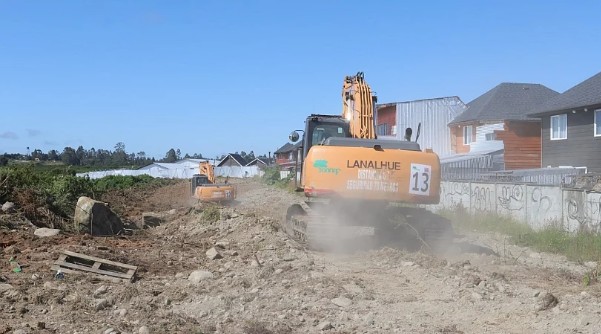Fast-growing oak and raulí hybrids developed in Chile for new productivity and afforestation
The natural combination of both species is being tested in various environments, identifying genotypes for good growth and quality of native wood. The research has received new funding to continue for four more years.
Two projects from the Faculty of Forest Sciences and Natural Resources at the Universidad Austral de Chile aim to diversify timber production and obtain native trees with the best characteristics for this purpose. Through the collection of natural hybrid plants and controlled crossings, the so-called RoRa is being successfully developed: hybrid plants that are half oak and half raulí.
The first research project was supported by the Foundation for Agrarian Innovation (FIA), titled "Generating a new afforestation option using oak-raulí hybrids as a high-productivity and sustainable adaptation alternative in the face of climate change scenarios." Work was carried out in the regions of Los Ríos, La Araucanía, and Biobío. The second project was an Innovation Fund for Competitiveness (FIC), managed by the Regional Productive Development Corporation of Los Ríos, titled "Development of a hybrid genetic base of oak-raulí for establishing high-productivity commercial plantations," focused on this region.
In this line, both projects are complementary and are led by Dr. Fernando Droppelmann, an academic from the Institute of Forests and Society at the Universidad Austral. He explained that in 2022, Stage II of these projects began, fulfilling a dream since both the Los Ríos Regional Government and FIA have recognized that this line of work must be consolidated and bear fruit through a long-term program, not just short-term projects. This merits special recognition for the technical teams and authorities of both entities.
"In the FIA project, we have collected hybrids from nurseries across Chile—natural material. In Los Ríos, we are developing them through controlled crossings by the project team and collecting only regional natural hybrid plants. Through hybridization, we aim to combine the best attributes of oak and raulí in these trees. Oak has high adaptability to different site conditions (soil and climate), unlike raulí, which has a more restricted territorial distribution. On the other hand, we seek raulí's growth habit and wood properties, which are more valuable due to its applications and industrial workability, increasing the wood's value," said Dr. Droppelmann, recognized as Researcher of the Year 2022 in sustainable development by the Los Ríos Regional Government.
What evidence has been gathered from these studies?
One of the main results is that, for the first time, there are human-made controlled-cross plants confirmed to be 50% oak and 50% raulí. Additionally, a highly effective vegetative propagation system has been developed to mass-produce this valuable material. The requirement for a hybrid to be field-evaluated is that at least 70% of mini-cuttings root successfully—hundreds already meet this. We expect rooting rates above 80% in a few years. This is historic.
These hybrids occur naturally in native forests where both species coexist, more frequently than imagined. Introgression occurs—for example, a raulí-oak hybrid backcrossing with a parental species. If crossed with raulí, the offspring appear morphologically like raulí but are not pure. We also confirmed that raulí and oak share a significant part of their genome.
Second, we conducted controlled crosses using raulí as the mother and oak as the father (and vice versa), concluding that successful seed production is feasible when raulí is the mother. Now we have hybrids that are exactly 50% raulí and 50% oak.
Trials are installed in various terrains from Vilcún to La Unión, expanding with support from FIA and the Los Ríos Regional Government.
A new afforestation policy announced by the Minister of Agriculture focuses on native species. Could this hybrid be a good option?
Chile needs forest diversification and native forest recovery. The solution is superior genetic material with complementary traits. We are convinced these projects will provide a real afforestation alternative with native species, superior genetics, and reasonable costs.
Early hybrids planted in 2017 show remarkable growth for native species. Some hybrids reach two meters in their first year and six meters at four years, with significant growth variations among types.
My academic and professional goal is finding applied solutions for effective forestry use. We must create jobs and well-being for our region and country. After working with pine and eucalyptus, since 2010, with support from the Forest Genetic Improvement Cooperative, I’ve focused on native species like raulí and RoRa hybrids to offer landowners the best options.
Can RoRa hybrids be planted successfully today?
Yes. Some groups show extraordinary growth in trials between La Araucanía and Los Ríos, with notable differences. Several trials are planted, and future managed stands are planned.
In a few years, wood property analysis will allow selecting trees for growth and form, tailoring wood type. With many options, growers can choose oak-like adaptability with raulí-like growth and wood properties—raulí being more valuable industrially.
How does this research align with Chile’s afforestation and carbon neutrality commitments?
Chile’s unmet targets stem from limited quality native plant availability and forester disinterest. Bridging these requires proving native species grow well, yield attractive products, and are profitable.
To compete with natives, they must grow fast under intensive forestry—meeting market demands for consistent volume, quality, and price.
The two best native options are raulí (where it thrives) and oak-raulí hybrids. These can spur a new native-based industry, alongside non-timber forest products.
Global intensive plantations seek homogeneous raw material to optimize industrial processes, increasing standing timber value.
Larger, uniform trees reduce harvest, loading, and transport costs, while industrial efficiency cuts waste and energy use—boosting economic and environmental benefits.
Without adopting pine/eucalyptus methods, Chile will lag 20–30 years in productive native alternatives, facing operational and market realities.
Our goal is offering technical choices—planting the right species in the right site ensures socio-economic and environmental sustainability.
Over two million erosion-prone hectares in Chile need careful planting decisions. Our material is tested across environments—foothills, valleys, and coasts—to identify optimal genotypes.
Hybrids in the forestry world
While native hybrids are early-stage, exotic hybrids like Brazil’s Urograndis (Eucalyptus grandis × urophylla) or Chile’s Gloni (E. globulus × nitens) show success, blending growth, cold tolerance, and wood quality.

















